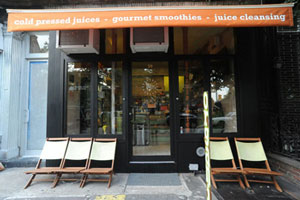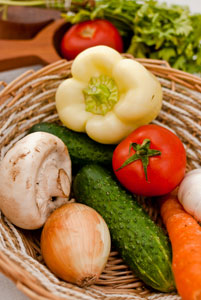 From the exterior, The Juice Press may seem like many of the other smoothie and juice bars that can be found in any metropolitan area in the U.S. But this particular shop, with a location in the East Village and another soon to be opening, offers only organic and raw foods. All of the juices are cold-pressed and the menu includes sandwiches, chia seed pudding, soups, vegan desserts and salads.
From the exterior, The Juice Press may seem like many of the other smoothie and juice bars that can be found in any metropolitan area in the U.S. But this particular shop, with a location in the East Village and another soon to be opening, offers only organic and raw foods. All of the juices are cold-pressed and the menu includes sandwiches, chia seed pudding, soups, vegan desserts and salads.
Shops like the The Juice Press are proof of growing interest in raw diets. Supporters argue that raw plants are the richest source of nutrients, and that eating a diet consisting solely or mostly of raw foods will result in better health.
Marcus Antebi, founder of The Juice Press, came to raw foods in the course of his competitive muay thai boxing. “I was trying to get an edge with my training,” he explains. Antebi found that drinking freshly pressed juice and consuming raw foods helped him maintain a high level of physical activity without bulking up.” I had an ulterior motive, I wasn’t trying to seek ultimate health, I was really just trying to get better output.”
Watch our interview with Marcus below …
Today, Antebi’s diet is about 90 percent raw, and he works closely with Dr. Fred Bisci, who has been a supporter of the raw food movement for over four decades. “A 100 percent raw food diet is really not optimal for everyone,” explained Antebi. “Most people who are doing that have nutritive deficits.” He explains that a diet that’s 70 to 80 percent raw is more fitted to most people’s needs, and that you can still enjoy the benefits of raw foods without converting 100 percent. “A 70 to 80 percent raw food diet is an amazing diet, and people that live in that parameter will live 100 years, and they’re not going to get sick, and they’re not going to have seven medications on their tab by age 60.” Less inflammation is another benefit of eating more raw foods, and Antebi attributes a higher sense of mental clarity to his diet.
The primary sources of raw nutrition come from seeds, nuts, fruits and veggies, all undeniably healthy elements. But Antebi further argues that what you leave out of a diet is just as important as what’s included. The first step for those interested in going raw “is to look at their diet and really honestly evaluate the things that they know they have to leave out.” That means cutting out caffeine, most animal products, artificial sweeteners and alcohol. He also warns against starting a raw diet or starting a raw cleanse if you are taking psychopharmacological medications, like antidepressants or sleeping pills, because the effects of the drugs may be amplified.
If you want to try a raw diet, it’s important to become informed about the nutritional content of food, so as not to become deficient in any essentials. “The next step is to really understand what food combining is, how much they actually need to eat–like if they’re overeating or not,” said Antebi. “I think they really have to learn a little bit about the technical mechanics of nutrition.”
 Few health and medical experts will argue against eating more fruits and vegetables, however there is only preliminary research showing the benefits of a mostly-raw diet. People eating mostly raw plants are particularly susceptible to deficiencies in iron, omega-3s and B12. B12 presents a particularly difficult problem for those who eat a vegan or raw vegan diet, because B12 is only present in animal products. The American Dietetic Association recommends that people who eat a strictly plant-based diet consider taking a vitamin B12 supplement or eating B12 fortified nutritional yeast. You may want to eat some fish, eggs or dairy in the non-raw part of your diet.
Few health and medical experts will argue against eating more fruits and vegetables, however there is only preliminary research showing the benefits of a mostly-raw diet. People eating mostly raw plants are particularly susceptible to deficiencies in iron, omega-3s and B12. B12 presents a particularly difficult problem for those who eat a vegan or raw vegan diet, because B12 is only present in animal products. The American Dietetic Association recommends that people who eat a strictly plant-based diet consider taking a vitamin B12 supplement or eating B12 fortified nutritional yeast. You may want to eat some fish, eggs or dairy in the non-raw part of your diet.
Of course, such a restrictive diet is off-putting to many. “There are certain people who need certain things in their diet, so they don’t kill themselves,” says Antebi. “They can’t get down the block without two cups of coffee.” His one-diet-doesn’t-fit-all attitude is refreshing, acknowledging that 100 percent raw isn’t for everyone. “You have to make yourself into your own human experiment, because there are so many millions of variables in the human body. A lot of it’s going to be based on how you feel.”
After our interview, we headed over to The Juice Press for some samples. I picked a bottle of juice called “the meal {B}” made from spinach, cucumber, celery, apple and spirulina, which I later found out is a kind of cyanobacteria that’s high in protein. The taste was, well, very healthy, but it did leave me feeling good for the rest of the afternoon.
